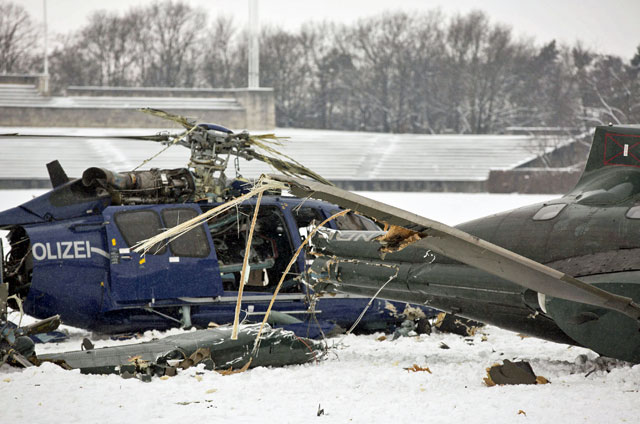A rotorwash-generated white-out appears to have been a significant contributory factor to the 21 March fatal collision of two German Federal Police helicopters while on a training exercise at Berlin's Olympic Stadium.
One pilot was killed in the accident when a Eurocopter AS332 L1 hit another aircraft that was already on the ground at Maifeld, just outside the stadium.
According to the initial findings of Germany's BFU air accident investigation agency, the three-ship flight attempted to land at around 10:28 local time, having completed two circuits of the landing area.
However, as the AS332 manoeuvred into position, a snow cloud generated by its own rotorwash and a preceding Super Puma's 30s touchdown appears to have obscured a third aircraft, an EC155, which had already landed, says the BFU. The two heavier aircraft had also switched their agreed landing positions, it adds.
As the first Super Puma descended, with two pilots and 13 police officers on board, it collided with the EC155, rolling to the right and it "rolled in the snow cloud [and] completely disappeared", says the BFU. "From the snow cloud rotor blade pieces and other parts then flew out."
 |
|---|
Rex Features |
It came to rest on its right-hand side with its tail boom lying at right angles around 1m (3.28ft) from the main body of the wreckage. The EC155, meanwhile, suffered extensive damage to its rotors and the fuselage was snapped at the junction with the tail boom.
Wreckage from the larger helicopter's main rotors penetrated the cockpit of the EC155, says the BFU, killing its pilot and injuring a further eight people, four seriously.
Weather data from nearby Berlin Tegel airport at the time of the accident recorded visibility of 1,800m with broken clouds at 800ft and 1,100ft and a 5kt (9.25km/h) wind. However, there was 18cm of accumulated snow, with 5cm of fresh snowfall.
The Maifeld site had accumulations of 17cm, with around 15cm in the landing area.
German police operating procedures say that a landing site should either be cleared or the snow compacted. However, this had not been carried out at Maifeld, says the BFU.
Briefings centred on the dangers of winter landings had been given by the BFU to the helicopter squadron in December, notes the report.
All the flightcrew involved were experienced, with the pilots having accumulated at least 4,000h each and co-pilots 3,000h.
The affected squadron operated 17 helicopters, providing air support to the states of Berlin, Brandenburg and Saxony.
Flightglobal's Ascend Online database lists the AS332 as a 1988-built airframe, while the EC155 dates from 2001.
Source: Flight International























